The animal kingdom is a fascinating topic of research, learning, and understanding. Be it kids, children, or even adults – there usually isn’t a single age group that fails to get mesmerized by the unique variety of the group above.
If you were to classify them, there could be many ways. For example, you could classify them based on their native lands, their eating habits (herbivores, carnivores, or omnivores), their reproduction methods, and so on.
Let us try classifying them alphabetically, shall we? Let us start with K. We bet you thought about koalas and kangaroos. But more animals start with K. In this article, we will tell you about that, and we are sure this listicle will blow your mind.
So, let us delve into the very interesting topic concerning the matter related to the interesting animals that start with K.
The Best of the Animals Whose Names Start with K
We have learned the names of common animals that start with K since childhood. Take killer whales, komodo dragons, kingfishers – we’ve heard of them. So we won’t go through the same common names over again.
In the listicle given below, we will tell you about 25 interesting animals beginning with the letter K that we are sure you’ve probably not heard about earlier (unless, of course, you’re a zoologist!).
1. Kakapo

Scientific Name | Strigops habroptilus |
Class | Aves |
Native Country | New Zealand |
This critically endangered species is the heaviest flightless parrot species in the world. Having moss-green feathers, the face of a kakapo resembles that of an owl.
Hence, it is also called the “owl parrot.” These are nocturnal animals that probably have the longest lifespan among all bird species (they can live up to 90 years!)
Interesting Fact: They are the only living lek-breeding flightless parrot species in the world, with females meeting the males for breeding purposes only.
2. Katydid

Scientific Name | Tettigoniidae |
Class | Insecta |
Native Country | Every continent in the world (except Antarctica) |
One of the most unique animals, the katydids, are close relatives to the grasshoppers. Their distinguishing feature is their long antennas that may extend up to the entire length of their bodies.
These nocturnal insects hold up their body like a roof and communicate with each other via ears placed on their legs.
Interesting Fact: They derived their name from their characteristic mating sound, “Kay-tee-did” pr “Kay-tee-did-did,” which can be as loud as 20 KHz!
3. Keeled Earless Lizard

Scientific Name | Holbrookia propinqua |
Class | Reptilia |
Native Country | Southern Texas and Coastal Mexico |
The keeled earless lizard is one of the most interesting animals. Right from its physical appearance to male behavior when mating – there is not one aspect that is far from startling. It prefers to live near dry sandy areas and dunes, and its color is the perfect camouflage for its habitat.
They prefer living in solitude except during the breeding season when they mark their territories by bobbing their heads and doing “push-ups.”
Interesting Fact: Their tails are larger than their heads and bodies! When attacked by a predator, the tail falls off, and they escape by burying through the sand using the head.
4. Keen’s Myotis Bat
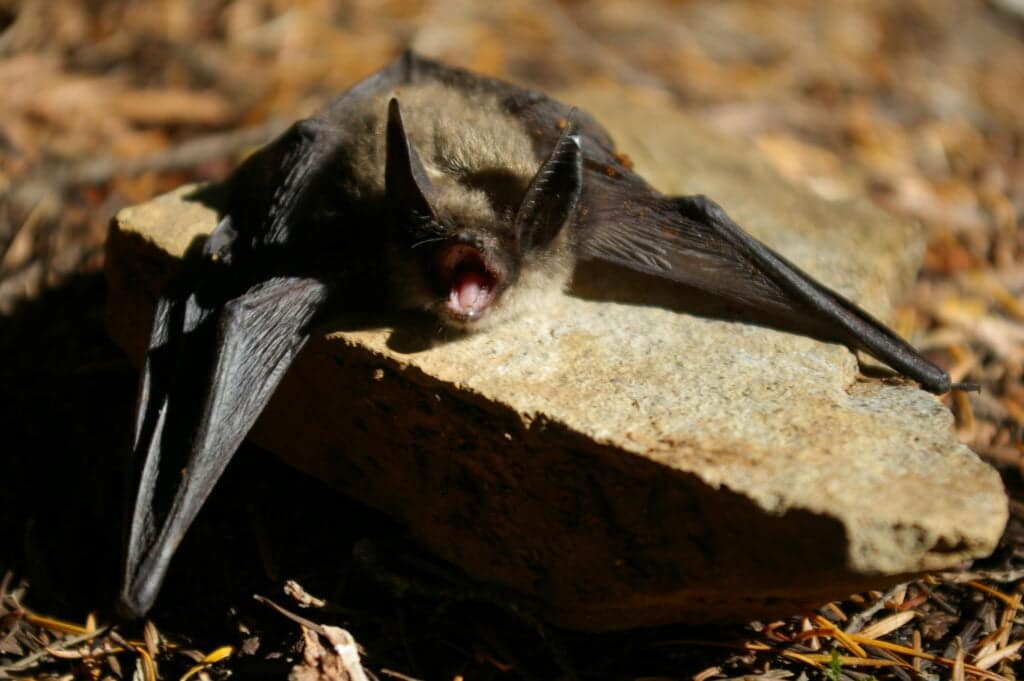
Scientific Name | Myotis keenii |
Class | Mammalia |
Native Country | United States and Canada |
One of the rare animals that start with K, the Keen’s Myotis Bat, is small and has long ears. These ears help the bat locate its prey by detecting self-emitted high-intensity, low-frequency echo waves. They are mostly found in damp places like caves, crevices, old hollow trees, and the like.
The females can give birth to single pups, and they reside in maternity colonies for the same from early June to mid or late July. They fly slowly when foraging prey, which includes insects, spiders, or moths.
Interesting Fact: It can glean prey or even prey on its wings.
5. Kentucky Warbler

Scientific Name | Geothlypis formosa |
Class | Aves |
Native Country | United States |
One of the cutest animals, the Kentucky Warbler, is not as cute regarding its behavior. Highly aggressive when marking its territory, this bird usually makes its nest on the ground. The nests are usually placed under the shade of herbs or shrubs.
A bright-yellow colored bird, it has a spectacle-like marking around the eyes. Hence, it looks like it is wearing black cat-eye glasses. They are insectivores and have pinkish legs.
Interesting Fact: The males constantly sing a two-note song during the mating season to attract the opposite gender.
6. Keta Salmon

Scientific Name | Oncorhynchus keta |
Class | Salmonidae |
Native Country | North Pacific and the Beringian Arctic (coastal rivers) |
Though not as physically majestic as other species of salmon, the Keta salmon is one of the weird animals. They are anadromous species; that is, they can survive both in fresh water and seawater.
Different names, including chum salmon, dog salmon, or silverbrite salmon know it. It prefers cold waters and may swim up to 2000 miles to reach its spawning grounds. After spawning, however, they die and become forage for eagles.
Interesting Fact: They can change their skin colors! During spawning, the males change the colors on their backs to olive green or even black and also develop a snout-shaped structure (like a hooked beak).
7. Key Deer

Scientific Name | Odocoileus virginianus |
Class | Mammalia |
Native Country | Florida Keys |
Key deer are named so because of the place they are natives of. They are nearer the size of a dog than other deer species and are also called “toy deer” because of their size. One of the endangered animals, the Key deer, does not fear humans.
They have brownish to reddish fur with an undertone of white on their bellies and the undersurface of their tails. They have hooves and are the largest living herbivores in the Florida Keys.
Interesting Fact: Males have antlers that shed off and regrow every year. Females do not possess antlers.
8. Kiko Goat

| Scientific Name | Capra aegagrus Hircus |
Class | Bovidae |
Native Country | New Zealand |
In Maori dialect, “Kiko” means meat, primarily what they are reared for, along with milk. They are a cross between the dairy goat and the feral goat. Hence, they are very hardy and low maintenance. Usually a white or cream color, the Kiko Goat has a self-regulatory fur that acts as a defensive adaptation for withstanding the extreme cold of the mountainous regions.
The long drooping ear also adds to this feature. Despite their long and curved sturdy horns, they are not much of a fighter and generally cannot defend themselves.
Interesting Fact: They can breed all year round, and a pedigreed male Kiko Goat can cost $1000 and more!
9. Kinkajou
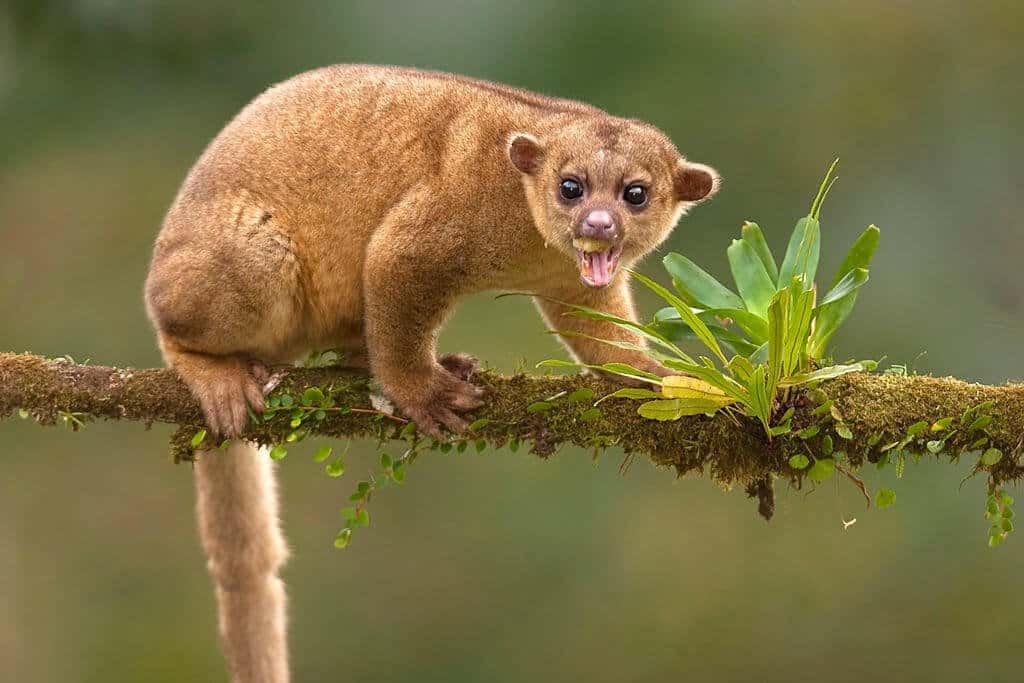
Scientific Name | Potos flavus |
Class | Mammalia |
Native Country | Central and South America |
One of the very interesting wild animals, the Kinkajou, belongs to the family of raccoons. Often known as “honey bears” because of their appearance and love for honey, they usually have brownish-yellow fur, which appears orangish because of their reflective capacity.
They have webbed feet and can feed upside down from trees. They emit a loud chattering sound which can be heard from afar but can rarely be seen. Their prehensile tail acts as a third limb for grasping and provides insulation during the winter months.
Interesting Fact: Their spine allows them to pivot 180 degrees between the head and the pelvis, and they can run backward, too!
10. Kit Fox

| Scientific Name | Vulpes macrotis merriam |
Class | Mammalia |
Native Country | Southwestern United States and Northern and Central Mexico |
The smallest among the foxes, they are adapted to survive in harsh desert conditions. The soles of the Kit Fox have hair that prevents them from sinking into the sand by distributing their body weight equally.
Their enormously large ears, in proportion to the size of their bodies, provide them with an acute sense of hearing, along with thermoregulation properties.
They are skilled in making underground burrows that not only shield them from the extremes of temperatures but also act as den caves for surviving larger predators.
Interesting Fact: They are monogamous and raise their pups together.
11. Kiwi
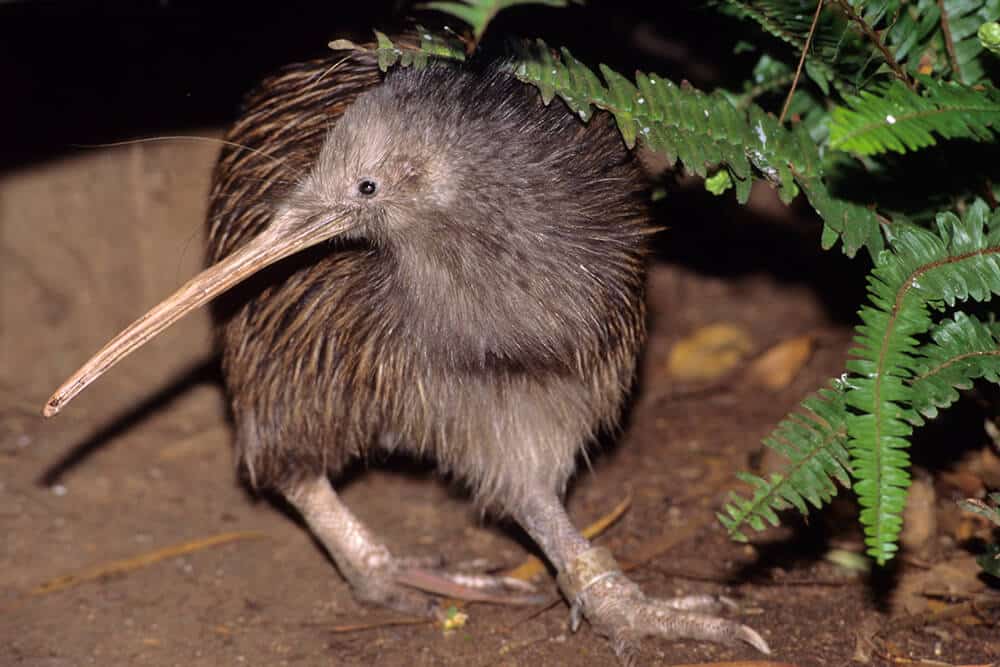
Scientific Name | Apteryx australis |
Class | Aves |
Native Country | New Zealand |
Not just a citrus fruit, the Kiwi bird is a distinctive addition to the list of names of animals that start with K. The national bird of New Zealand is a flightless bird that almost looks like a mini ostrich. The feathers are soft and loosely attached to the body.
Two characteristic points to note include that they have marrows in their bones (just like mammals) and are never fed by their parents. They have to learn the tricks of survival early on. When they first appeared, their habitat was free of predatory land mammals.
Currently, due to the advent of large groups of the latter and extensive deforestation, they are on the verge of extinction.
Interesting Fact: They are the only birds with nostrils in their beaks and, hence, have a heightened sense of smell.
12. Klamath Black Salamander

Scientific Name | Aneides klamathensis |
Class | Amphibia |
Native Country | United States of America |
One of the least known wild animals, these are extremely gorgeous. Their shiny, sleek, oily black color is a marvel to witness and appear luminous in the dark. With a tinge of green or specks of bronze, the Klamath Black Salamander is a lungless amphibian that breathes through its skin.
It prefers moist areas and houses itself in moist logs and crevices. Their forage includes millipedes, ants, and termites in the initial stages and progresses toward larger insects as they grow older.
Interesting Fact: It has a prehensile tail with the help of which it sometimes climbs trees.
13. Klipspringer

Scientific Name | Oreotragus oreotragus |
Class | Mammalia |
Native Country | Eastern and Southern Africa |
You thought only dogs were loyal? Wait till you learn about these prominent animals – the Klipspringers. In the Afrikaans language, their name means “rock jumper.” And just like the name suggests, they are excellent rock climbers, being able to jump up to 10-12 feet in the mountainous terrains that they live in!
They are monogamous and look after each other. These nocturnal animals have distinguished cylindrical-shaped hooves that give the appearance of them standing “tip-toed.” The hairs on their bodies make a rustling sound.
Interesting Fact: They have a hollow layer of fur that protects them from injuries on uneven and rough mountain slopes.
14. Knight Anole
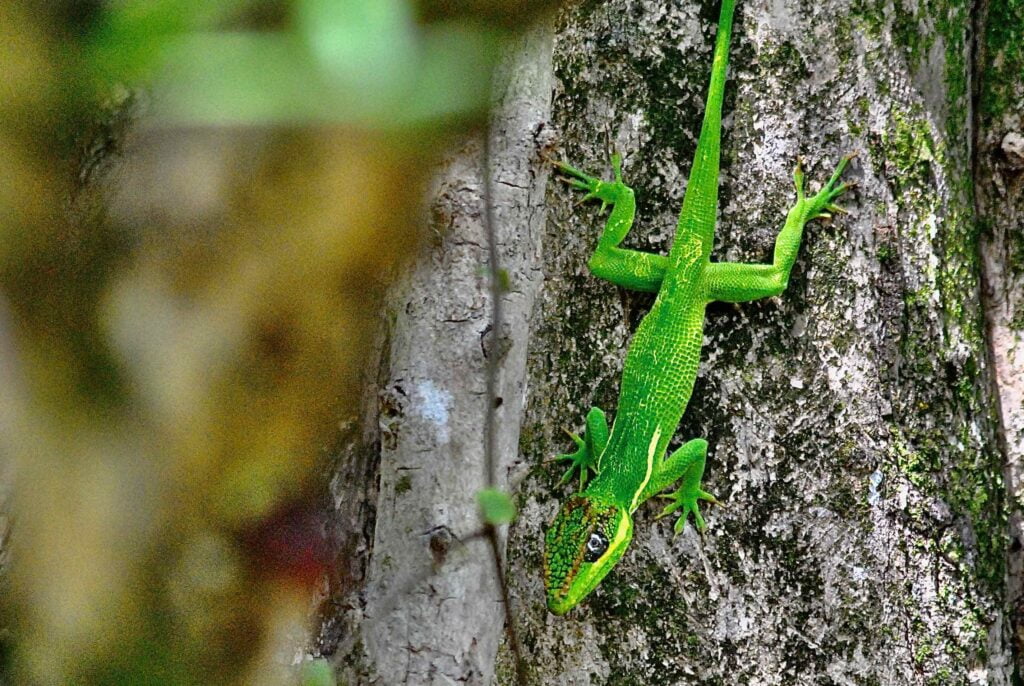
Scientific Name | Anolis equestris |
Class | Reptilia |
Native Country | Cuba |
With a large and bony head that resembles the shape of a knight piece in chess, the Knight Anole is the largest among anoles. The males are somewhat larger than the females, and they are polygynandrous and have multiple sexual partners during the mating season.
No wonder they multiply rapidly. They are unable to withstand cold temperatures and are solitary and extremely territorial. They are diurnal and stand bold in the face of danger.
Generally aggressive, they are generally docile in captivity.
Interesting Fact: They do not like to be touched and will most likely deliver a painful bite if you try touching them. It will stand up on all fours and turn green, giving a vicious look if it feels threatened.
15. Kodiak Bear

Scientific Name | Ursus arctos middendorffi |
Class | Mammalia |
Native Country | Alaska |
The Kodiak Bear falls under the category of omnivorous animals that start with K. They are heavyweight but are excellent swimmers. They prefer living alone and communicating with other members through special sounds. They have poor eyesight, compensated by an acute sense of hearing and smell.
They are brown, just like other bears. Most active during the summer (when they eat a lot), they survive on their summer meal by hibernating throughout the winter.
Pregnant females are the first to go into hibernation, with males being the last.
Interesting Fact: They are the second largest bears after polar bears, weighing up to 1500 pounds (the weight of a piano!) or more.
16. Kodkod

Scientific Name | Leopardus guigna |
Class | Mammalia |
Native Country | United States of America |
Imagine a cat’s face in a leopard’s body – this is the Kodkod, one of the fascinating wild animals. It has a short but stout tail that helps it climb trees to avoid predators and measures about half the total length of the body.
It also has comparatively larger claws. Having yellowish fur with black polka dot-like spots all over, the Kodkod is the smallest cat species in the world. It is active throughout the day but prefers searching for food during the dark.
Interesting Fact: It helps keep the rodent population in check. But much to the woe of farmers, it attacks domestic animals, too.
17. Komondor

Scientific Name | Canis lupus |
Class | Mammalia |
Native Country | Hungary |
Bred as a guard dog for guarding cattle herds, the Komondor is one of the most loyal animals that start with K. It has two layers of coat – a soft coat underneath a coarse and thick coat, both of which criss-cross to form a long and thick-matted coat, giving it the appearance of a mobile mop.
They are strongly built and muscular, perfectly capable of chasing away and or knocking down predators in the face of grave danger.
Despite their heavy weight (which mainly comprises the weight of the coat), they are extremely agile and highly energetic.
Interesting Fact: The Komondor has been declared one of Hungary’s national treasures, and cross-breeding is strictly prohibited.
18. Kookaburra

Scientific Name | Dacelo novaeguineae |
Class | Aves |
Native Country | Australia |
A native of New Guinea and Australia, the Kookaburra lives in a diverse range of habitats, ranging from tropical jungles and savannahs right up to humid areas and near water sources.
They have a characteristic call that resembles nefarious human laughter and is heard early morning and right after sunset. Owing to this nature, they are also called the “Bushman alarm clock” and the “laughing kookaburra.”
These come under the list of predatory animals that start with K, feeding on mice, insects, young ones of other birds, or even venomous snakes. Due to their physical appearance, they are often termed “terrestrial kingfishers” (although they are not too fond of fish).
Interesting Fact: They are known to steal food from snakes.
19. Kori Bustard
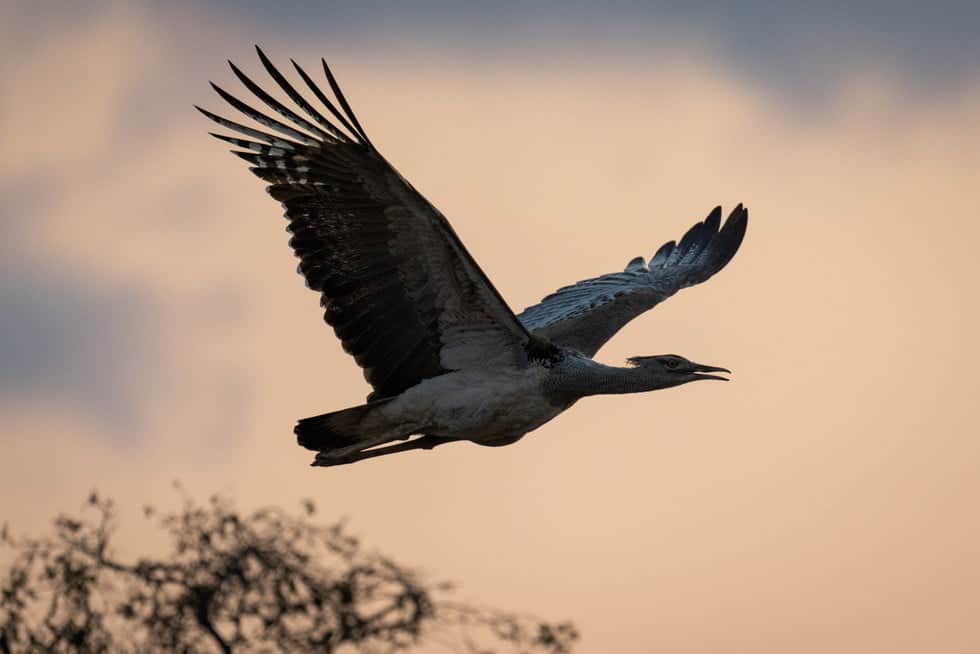
Scientific Name | Ardeotis kori |
Class | Aves |
Native Country | Africa |
The national bird of Botswana, the Kori Bustard, is the largest flying bird in the world. However, it spends about 70% of its time on the ground. Males are heavier than females, and the bird is easily distinguishable and identifiable by its wing and crest size.
These birds are opportunistic omnivores and breed in hilly areas. The feathers on their neck are loose, giving them a fluffier appearance. These birds usually come in three colors: brown, beige, or white.
Interesting Fact: The male Kori Bustard is polygamous and mates with multiple females during the breeding season. It engages in a courtship ritual through dance before mating.
20. Kouprey

Scientific Name | Bos sauveli |
Class | Mammalia |
Native Country | Southeast Asia |
One of the most intriguing (currently) zoo animals, this ox species, is critically endangered and on the verge of extinction owing to deforestation and global warming. Kouprey are mainly herbivores and spend most of their time grazing. The female usually leads the herd.
They are reddish when young but change color to gray, dark brown, or even black after 6 months. Diurnal in nature, they prefer staying out at night and in their hideouts during the day. Horns are their most prominent feature (lyre-shaped in females and arch-shaped in males).
Interesting Fact: They frequently take baths in the mud and water holes as it helps repel insects and protects them from the harsh sun.
21. Kowari

Scientific Name | Dasyuroides Byrnei |
Class | Mammalia |
Native Country | Australia |
A bushy-tailed marsupial, the Kowari is a seemingly adorable rat in Central Australia. It prefers dry areas and deserts and is a great climber, having the ability to jump up to 18 feet from the ground!
With pink snouts and ears, they have a gray-colored body, and their long tail distinguishes them from other rats. They are carnivorous, and their prey includes lizards, rodents, spiders, and insects.
Usually friendly in known environments, they can deliver dangerous and painful bites when feeling threatened.
Interesting Fact: They don’t drink water as they derive it solely from their diet – an adaptation that helps them survive in the desert.
22. Krill

Scientific Name | Euphausiacea |
Class | Malacostraca |
Native Country | Japan, Russia, and Ukraine |
One of the smallest animals that start with K, the Krill is one of the most important faunas of the marine ecosystem. Having a transparent body with a thick shell made up of a carbohydrate called “chitin,” they act as food for plenty of other aquatic animals.
They feed on zooplanktons and phytoplanktons and migrate in large swarms (the size of which can stretch up to 30,000 crustaceans!).
They are adept in Lobstering, a survival strategy by which they can rapidly swim backward (crossing up to 10 body lengths per second!) when attacked by a predator.
Interesting Fact: They radiate a bioluminescent glow like fireflies and, because of their large swarm size, are visible even from satellites! What’s even more interesting is that this tiny creature has the largest biomass on the planet!
23. Kudu

Scientific Name | Tragelaphus strepsiceros |
Class | Mammalia |
Native Country | Africa |
A member of the antelope family, the Kudu is one of the most prominent animals that start with K. The males have distinguished curved horns that are of utmost significance to the local Khoikhoi tribe for their religious practices.
They are of tawny brown or gray color, having multiple thin whitish stripes. A prominent chevron on their nose is a characteristic feature. The Kudus live in herds of as many as 24 individuals!
Their skin color camouflages them from land predators when grazing, and other survival instinct includes staying absolutely still when grazing.
Interesting Fact: They are super-fast runners, running at a speed of up to 60 mph when attacked!
24. Kudzu Bug

Scientific Name | Megacopta Cribraria |
Class | Insecta |
Native Country | Australia and Asia |
One of the most notorious animals that start with K are pests that feed on the Kudzu plant. However, they also derive nutrition from other field crops like soybeans and legumes, causing massive losses. They also lay eggs on the leaves of the crops, which act as parasites as soon as they hatch.
They are olive green with brownish speckles. Kudzu Bugs feed on these plants through piercing mouthparts lodged in their beaks, which they keep underneath their bodies when not using them. They are also known as “globular stinking bugs,” “plataspids,” or “lablab bugs.”
Interesting Fact: They secrete a sticky substance that causes irritation to the human skin and is often mistaken as a bite.
25. Kuvasz

Scientific Name | Canis lupus |
Class | Mammalia |
Native Country | Hungary |
Like most other dog breeds, this breed is the perfect companion to keep as a pet. In addition, they are exceptional guard dogs because that’s who they were originally meant to be (they were brought to the Carpathian basin by the nomadic Magyars for guard livestock, probably from Tibet when they settled there).
The term “kuvasz” comes from the Turkish word kawasz, meaning “armed guard of the nobility.” With almond eyes and a thick, coarse fur coating, they are highly energetic and playful large working dogs but are costly to maintain.
Interesting Fact: Given the widespread popularity of this breed for their valor as guard dogs, the Hungarian nobility once restricted their ownership only among themselves.
Conclusion
The list is endless when it comes to noting “animals that start with K.” After all, the diversity of the ecosystem never fails to amaze us!
Be it K, J, A, B, C, or any other alphabet – there is so much fauna that is yet unknown to us, which we are trying to decipher.
Till then, hopefully, these listicles will enrich your knowledge about lesser-known animals that have been discovered already but most people don’t know of.
Which animals did you not know about in the above list of animals that start with K? Add more names in the comments section below if you know.
Take out your animal picture books and tell us more interesting facts about these animals in the comments.




